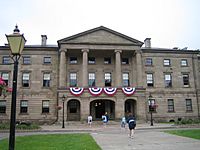Heritage Places Protection Act facts for kids
Quick facts for kids Heritage Places Protection Act |
|
|---|---|

Province House, where Prince Edward Island's legislature meets, became a Designated Heritage Place under the Heritage Places Protection Act in 2004
|
|
| Citation | R.S.P.E.I. 1988, c. H-3.1 |
| Territorial extent | Prince Edward Island |
| Enacted by | Legislative Assembly of Prince Edward Island |
| Date enacted | 1988 |
The Heritage Places Protection Act is a special law in Prince Edward Island, Canada. It helps to find and protect important places. These places can be part of our cultural heritage or natural heritage. This means they are special because of their history, culture, or natural beauty.
Contents
Protecting Special Places
This law makes sure that special places in Prince Edward Island are kept safe for the future. The Minister of Tourism and Culture is in charge of this. They create a list of all the "heritage places." These places have "historic resources." This means they are valuable for their history, old fossils (palaeontology), old human sites (archaeology), culture, nature, science, or beauty.
What are Heritage Places?
A heritage place can be many things. It might be a single building or a piece of land. It could also be a special trail or pathway. Sometimes, a whole area with many historic buildings is called a "heritage district."
Two Ways to Recognize Heritage Places
The Act has two main ways to recognize these special places. Each way offers a different level of protection.
Registered Heritage Places
A Registered Heritage Place is a site or building that has been studied. Experts agree it has historic value for the province. This recognition shows that the place is important. However, it does not add any rules for the owner. The owner can still make changes to their property.
Designated Heritage Places
A Designated Heritage Place is the highest level of protection. The Minister officially names these places. If a place is designated, the owner needs special permission. They cannot tear down or change the building without a permit. They also cannot build new things that might harm the designated land. This helps keep these very important places safe.
Special Plaques for Designated Places
Prince Edward Island has a special program for Designated Heritage Places. Owners of these places get a navy blue and gold plaque. This plaque shows everyone that the building is a recognized heritage site. It is given to the owners for free.
How Towns and Cities Help
The Minister can also let local towns and cities help protect heritage places. This can happen if the town agrees and has its own plan. This plan must show how they will save their local heritage. For example, Charlottetown and Summerside have their own programs. They help protect historic sites in their areas.

